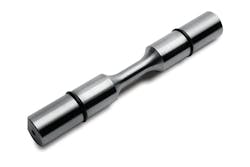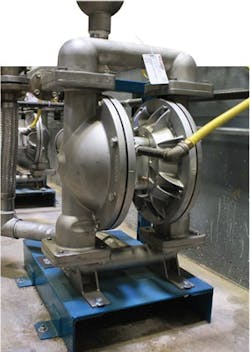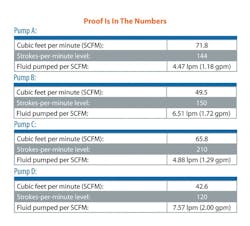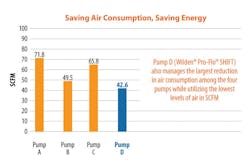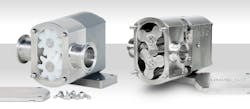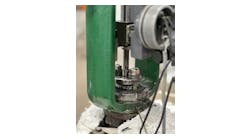Successful industrial operations measure success in many ways – such as operational equipment efficiency, productivity and safety, to name a few. Almost always, they can be grouped into one of three categories:
- Maintaining low operating costs
- Ensuring happy customers
- Providing a safe environment for employees
Image 1. Advanced ADS technology can reduce the operating costs for AODD pumps in many industries including chemical processing, food and beverage, oil and gas, pharmaceuticals and mining.
Happy customers and safe employees are typically easy to identify and measure. However, operating costs often have hidden components that are not so easy to quantify.
In the industrial sector, some significant operational costs – whether in the chemical processing, food and beverage, oil and gas, pharmaceutical, or mining industries – are the ones incurred for the purchase, operation and maintenance of pumps used during different production and transfer processes.
One hidden component from the operating-cost perspective is the electricity used by pump systems, which, per a Hydraulic Institute study, account for nearly 20 percent of the world’s electricity demand. Assuming 7 cents per kilowatt/hour, that equates to approximately $294 billion to operate pump systems. Therefore, energy consumption can make up close to 90 percent of the total life-cycle costs of owning and operating a pump.
Approximately 30 to 50 percent of the energy consumed by pump systems can be saved through equipment or control system upgrades. Considering all the usage estimates, simple arithmetic reveals that up to $147 billion of electricity costs will be charged to the industrial companies or the energy provider.
Since pump systems are ever-present in industrial manufacturing facilities and are crucial to the operation of many production applications, they are also ripe for operational improvements that can decrease energy consumption, resulting in lower operating costs for the facility manager and a more environmentally friendly carbon footprint.
This article shows how recent improvements in air-operated double-diaphragm (AODD) pump technology are helping industries reduce air consumption, which delivers many significant benefits for the operator and the environment.
The challenge
Two main challenges exist for industrial manufacturers with fluid-transfer operations. First is the fact that all pumping systems, no matter the technology deployed, can be operationally improved in some way so that they are more efficient and cost-effective to operate. Second, speaking specifically of AODD pumps, hidden electricity costs related to air consumption may be difficult to measure because those costs can be included in the expenses needed to operate other equipment in the plant.
Upon its invention more than six decades ago, AODD pump technology became sought after in the industrial and manufacturing sectors. AODD pumps are ideal solutions for many applications because of their simple design, which allows the displacement of a regulated amount of fluid from one of its two liquid chambers upon the completion of each pumping stroke. AODD pumps also feature only a few wetted parts that are dynamic: two diaphragms, which are connected by a common shaft, two inlet valve balls and two outlet valve balls.
Driving the diaphragms with compressed air instead of the shaft balances the load on the diaphragm, which removes mechanical stress from the operation and extends diaphragm life. This also allows the valve balls to open and close on the valve seats that direct liquid flow. This uncomplicated design and operation allows the operator to find the correct pressures and flows to optimize the AODD pump’s operation, making AODD pumps ideal for use with different liquid types, from crude oil and paints to cooking sauces and shampoos.
An AODD pump’s design, though, could leave its operation susceptible to higher rates (and corresponding costs) of compressed air usage. Namely, the earliest air distribution systems (ADSs), which comprise the AODD pump’s motor, would, at the completion of each stroke, produce a moment in which a small but still notable amount of compressed air would “overfill” the air chamber without any corresponding displacement of fluid. Think of this overfilling as similar to hitting the gas pedal in a vehicle while driving over a patch of ice: the wheels may spin, but the vehicle does not move forward, ultimately wasting gas or energy.
Knowing this, the search began to develop an ADS that could reduce the rate of air consumption related to the product flow rate while minimizing the overall amount of wasted air that does not enhance the product yield during the pumping cycle. If realized, this ADS type would positively impact an operation’s bottom line with improved production rates and reduced compressed-air consumption. While some notable enhancements to ADS performance had occurred, the troubling problem of wasted air continued at the end of each pumping cycle.
Controlled Comparisons
To create real-world conditions to measure the effectiveness of ADS technologies industry-wide, a controlled, objective head-to-head test was arranged comparing the industry’s top AODD pumps with traditional, electronically controlled and mechanically actuated ADSs. Common conditions of service seen in the field were replicated in the laboratory. This simulated application required that each pump produce a flow of 320 liters per minute (L/min) (85 gallons per minute [gpm]) against a head pressure of 2.1 bar (30 psi). To achieve a fair comparison between these competing pumps, each pump was operated at the inlet air pressure needed to meet the common condition of service. Air-consumption data was then recorded.
The data gathered in the objective AODD test revealed that Pump D (with the next-generation ADS) performed better than the competition in all three key points of measurement with the lowest air consumption in standard cubic feet per minute (SCFM), the lowest strokes per minute and the highest volume of fluid pumped per SCFM. Pump D averaged an overall 30 percent reduction in air consumption compared to Pumps A, B and C. It also managed the largest reduction in air consumption among the four pumps while managing the best overall volume of fluid moved per stroke, requiring the lowest strokes per minute.
AODD pumps solution
In 2013, Wilden developed a solution to this industry challenge with a new ADS called the Pro-Flo SHIFT. Its operation presented an entirely new way of looking at how AODD pumps operate and consume air.
To combat the inefficient use of air, it restricts air flow into the air chamber near the end of each pump stroke so that only enough air is introduced to keep the pumping process going. This is accomplished through the incorporation of an air-control spool that automatically meters the air to prevent overfilling with no reduction in product yield rates. The result is reduced air consumption while maximum operational efficiency and flow rates are maintained. This means that, in many cases, the new ADS can reduce air consumption by 60 percent when compared to the operation of competitive technologies while retaining desired flow rates.
In addition, the automatic efficiency gains of the system eliminate the need for the operator to manually dial in the efficiency or control it with an electrical system. This creates improved efficiency in AODD pump operation with no loss of flow rate. This ADS also delivers maintenance advantages because it minimizes wear on the diaphragms during operation through the optimization of every pump stroke.
Additional benefits of the optimized ADS include:
- Reduced total cost of ownership
- Faster setup time
- Ease of maintenance
- Drop-in configuration capability
- Ability to be retrofitted into certain existing AODD pumps
- Ability to be used in harsh operating environments
- No electricity required
- Completely submersible
- Environmental sensitivity
This ADS’s ability to reduce and optimize air usage and maintain or even improve flow rates can save the plant operator the cost of purchasing new pump equipment or compressed-air systems. The simplest way to increase a plant’s production capacity may be to replace the ADS in the existing AODD pumps with the most current ADS technology rather than buying new or additional pumping units.
Conclusion
For industrial operations, built-in costs of doing business (CODBs) will always exist. To mitigate these costs, recognizing what the CODBs are and finding ways to streamline them to create a more profitable business are important. Industries and facilities that rely on AODD pumps for their production and product-transfer operations can only realize the ultimate benefits of that technology if they optimize air usage.
The next-generation ADS effectively eliminates the problem of wasted air during the pump’s operation, resulting in optimized operating costs and a healthier bottom line for the facility operator.
Erik Solfelt is the diaphragm pump product manager for Wilden Pump & Engineering Co. LLC, a manufacturer of AODD pumps. He may be reached at [email protected] or 909-422-1741. Wilden is a product brand of PSG, a Dover company. PSG is comprised of several pump companies, including Abaque, Almatec, Blackmer, Ebsray, EnviroGear, Griswold, Mouvex, Neptune, Quattroflow, RedScrew and Wilden. To view the video documenting the laboratory pump demonstration of the Wilden Pro-Flo SHIFT versus other ADS systems described in the “Controlled Comparisons” sidebar, visit http://profloshift.com/proof.
Wilden Pump & Engineering Co. LLC – http://www.wildenpump.com
